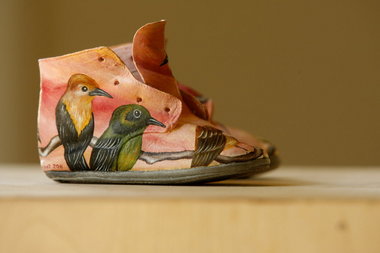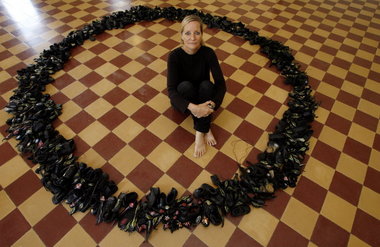Jacqueline Bishop returns with exhibit at Eichold
Published: Monday, August 22, 2011, 8:13 AM
By Thomas B. Harrison, Press-Register

Bishop got the idea for 'Losing Ground' when she saw discarded baby shoes in the streets of New Orleans and other cities in North and South America. (Press-Register/John David Mercer)
In the aftermath of Hurricane Katrina in 2005, artist Jacqueline Bishop found shelter and work in Mobile.
She also found a receptive new audience and venues for her environmentally conscious artwork. Among her many projects was “Made in New Orleans: A Survey of Contemporary Art from the Crescent City,” which opened in November 2005 at Space 301. Bishop was curator for that show.
In 2007 her “Veil Series” provided the inaugural exhibit for the new gallery at the Alabama School of Mathematics and Science.
She returns this week to the Eichold Gallery at Spring Hill College with “Memory and Landscape,” which includes two installations — “Black Memoria” and “Losing Ground: Imaginary Landscapes.” (See information box.)
“Both installations address the loss of landscape with similar materials but used in different ways,” Bishop says. “For example, discarded baby shoes and artificial birds are in both and represent future generations of humans and non-humans having to deal with loss of landscape or altered landscapes because of the decisions adults have made.”
Bishop says “Losing Ground: Imaginary Landscapes” began with the discovery of numerous discarded baby shoes in the streets of New Orleans and other cities in North and South America.
“It was astounding to encounter so many baby shoes in streets over the years and I couldn’t ignore their strong presence,” she says. “Discovering these little abandoned shoes left me with so many questions.
“I decided to collect them, recycle them into my creative process and treated them as paintings, gesso each shoe like a canvas, and paint landscapes on them. I consider the baby shoes landscape paintings, they are no longer mere baby shoes and they will not be included in a landfill, but have been given a new life. They represent our childhoods, our children and our future.”
The theme of Bishop’s artwork meshes perfectly with the social justice mission statement of Spring Hill College, says Eichold Gallery

New Orleans artist Jacqueline Bishop with her installation, 'Black Memoria,' at the Eichold Gallery on the Spring Hill College campus in west Mobile, Ala. (Press-Register/John David Mercer)
director Wanda Sullivan, an artist and member of the Spring Hill faculty.
Although Bishop doesn’t view her work as political, it does make the point emphatically.
“I’m very impressed by how she interprets the climate crisis through her work,” Sullivan says, “and it makes me think about the natural world and how connected it is to our world.”
“Black Memoria” is a 9-by-9-foot black wreath comprising artificial birds, baby shoes, bird nests, wire, string, acrylic and toys pieced together nest-like to make a wreath shape. The piece alludes to 16th- and 17th-century Dutch still-life paintings during the time of intense attention toward natural world objects and scientific illustration when the land would be completely industrialized and transformed.
“The historical and universal wreath represents death, birth, circle of life, circle of thorns on the head of Christ,” the artist says. “It symbolizes the beginning and the end.
“This piece was inspired by my visits to Grand Isle State Park after the BP oil spill. On April 20, 2010, I was in the Midwest serving birthday dinner to my mother who was recovering from brain surgery. As I was serving the table, I heard the news about the Gulf oil explosion in my home territory. I was not surprised about the explosion, but was horrified that 11 people died because of obvious corporate incompetence.
“I ended up a few weeks later getting passes and tours by Grand Isle authorities to view and document the beach damage when it was illegal to be anywhere near the beach,” Bishop says. “If anyone was caught on the beach they were stripped and examined for possible oil and corexit contamination.
“Seeing the oil-covered beaches, dead fish, oil-stained plants, thousands of tar balls and thousands of dead hermit crabs covering miles and miles of beach had the same effect as seeing the Amazon forest fires in Brazil or the aftermath of Katrina.
“The silence after devastation seems to create more silence — no birds, no wildlife, no life. “Black Memoria” is a memorial to the devastation of human and non-human loss, but also with hopes for regeneration of ourselves and our environment.”
Bishop, 56, is known for her paintings and installations that focus on landscape issues such as the politicizing of nature, species extinction and ecopolitical injustice. She has devoted 30 years to traveling in Third World countries and South American forests.
She received her master’s degree from Tulane University and taught art and environment at Loyola University and Tulane. She is author of “En Memoria Chico Mendes: A Tribute on the 10-Year Anniversary of His Death” and “Losing Ground: Imaginary Landscapes.”

Artistically reimagined baby shoes from Jacqueline Bishop's 'Losing Ground: Imaginary Landscapes' show at the Eichold. (Press-Register/John David Mercer)
Bishop founded and organized ArtSpeak for six years at the Contemporary Arts Center, and for five years she was host and co-produced the award-winning program “Louisiana Artist” for WWNO, the public radio affiliate in New Orleans.
She has exhibited and lectured in Europe, Asia, South America, Canada and the United States and is a grant recipient of the Pollock-Krasner Foundation and Joan Mitchell Foundation.
Six years have passed since Hurricane Katrina, and Bishop says much has changed.
“I see our landscape, the Gulf Coast as a ‘new landscape,’” she says. “We are different people. We were beat up, knocked down, challenged to the max. Katrina washed away the imaginary veil revealing truths to the world and to us about our inferior infrastructure, our poverty, our racism, our poor education, and all of the hidden social ills we ignored.
“But the storm also confirmed to the world our significance, our unique culture, people, our role, our misunderstood landscape — and yes, we have artists.
“We entered the digital world. Color slides became useless. Documentation became an obsession since so many slides, artwork (and) evidence of culture were destroyed. We invested in digital and overnight everyone became a photographer. For the first time there is more environmental awareness and acceptance toward considering change with these social issues.”
Bishop says some of the changes in New Orleans have been motivated by the hundreds of artists who relocated or returned to different parts of the city.
“For example, before Katrina no one knew much about the Ninth Ward,” she says. “Now there are over 10 art galleries there and numerous young entrepreneurs bringing new ideas and businesses. It’s a ‘real happening’ with coordinated 2nd Saturday gallery openings that are very different from the Julia Street galleries and very different from the Magazine Street galleries.
“All of the art institutions now have new art leaders — NOMA, Ogden Museum of Southern Art, the (Contemporary Arts Center) all have new curators or directors,” she says. “The Joan Mitchell Foundation from NYC has opened an office in New Orleans and participates in exhibitions, funding projects; a strong presence here.
“There are new art publications, recording studios, film studios that were not here before the storm. New Orleans is experiencing a cultural renaissance.”
